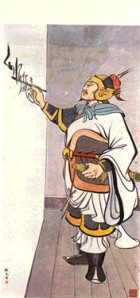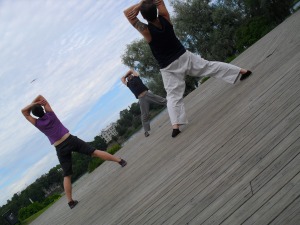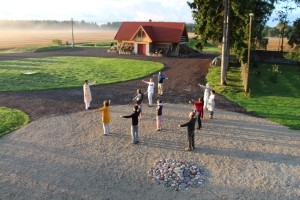The purpose of this article is to compare two fascinating systems of warming up, respectively belonging to Kung Fu and Yoga paths: Pa Tuan Chin (八段錦, literally: Eight Pieces of Brocade), structured in twelfth century by master Yüeh Fei (岳飛, 1103-1142), and Energization Exercises, developed in 1916 by guru Paramahansa Yogananda. I will also attempt to share my personal experience with both practices, sharing my opinion about the benefit deriving from an alternate training.
Pa Tuan Chin was originally developed by a famous Chinese hero: master Yüeh Fei. He was a military general, expert in medicine, calligraphy and martial arts, best known for fighting the long campaign against the invading Jurchens, standing himself on the side of the Song emperor. Paradoxically, he was put to death by the Song government in 1142, betrayed by the emperor’s Chancellor. Legend attributes to Yüeh Fei the birth of several Kung Fu –styles. Pa Tuan Chin was meant to prepare mind and body to the practice of martial arts.
 Pa Tuan Chin (Baduanjin, in the Pinyin transliteration) is nowadays one of the most renowned methods of warming up belonging to Traditional Chinese Martial Arts. The name “Eight Pieces of Brocade” refers to the fact that the form is composed of eight different exercises. Brocade is a precious tissue. Filaments composing the tissue symbolise meridians (channels delivering energy throughout the body). Each exercise is meant to stimulate some specific body-organ, according to Traditional Chinese Medicine.
Pa Tuan Chin (Baduanjin, in the Pinyin transliteration) is nowadays one of the most renowned methods of warming up belonging to Traditional Chinese Martial Arts. The name “Eight Pieces of Brocade” refers to the fact that the form is composed of eight different exercises. Brocade is a precious tissue. Filaments composing the tissue symbolise meridians (channels delivering energy throughout the body). Each exercise is meant to stimulate some specific body-organ, according to Traditional Chinese Medicine.
But firstly, Pa Tuan Chin presents three basic goals: warming up the body, training the basic postures of Kung Fu, and exploring the interconnection between movement and breathing.
Throughout many centuries, Pa Tuan Chin spread all around China and eastern countries, and ultimately it reached other continents too. At the present moment there are many different forms displaying same name and it is impossible to be sure about their closeness to the original sequence. I have been practicing the Pa Tuan Chin taught by master Chang Dsu Yao (1918-1992), for about twenty years.
 I find it especially effective whenever I feel contracted, nervous or uncomfortable with my body and mind: Pa Tuan Chin –exercises, with their remarkable component of lengthening and stretching, re-establish my inner balance and open my attention. After the practice, I feel more rooted into “real” world and I feel open and stable, but also flexible and relaxed. Traditional Chinese Medicine teaches that contractions and obstructions throughout meridians obstacle the circulation of inner energy, producing sickness and diseases. Therefore, good health is related to a free flow of energy.
I find it especially effective whenever I feel contracted, nervous or uncomfortable with my body and mind: Pa Tuan Chin –exercises, with their remarkable component of lengthening and stretching, re-establish my inner balance and open my attention. After the practice, I feel more rooted into “real” world and I feel open and stable, but also flexible and relaxed. Traditional Chinese Medicine teaches that contractions and obstructions throughout meridians obstacle the circulation of inner energy, producing sickness and diseases. Therefore, good health is related to a free flow of energy.
Pa Tuan Chin is an art which combines inner work (breathing, meridians, concentration …) with a very detailed and sophisticated body-technique. The characteristic postures and gestures of Pa Tuan Chin challenge our skills in precision, balance, resistance and body-coordination.
Energization Exercises have been developed in 1916 by Paramahansa Yogananda: the first great Indian master who spent most of his life in the West, author of the spiritual classic “Autobiography of a Yogi”, and founder of the Self-Realization Fellowship. Energization Exercises are based on ancient Yoga-techniques and are meant to prepare the body for meditation.
By means of a proper use of breath, life force, and concentrated attention, Energization Exercises allow to draw abundant energy consciously into the body, purifying and strengthening all the body parts systematically in turn. The Exercises rely on the basic idea that it is possible to draw Cosmic Energy into the body through the point where the scull joins the spinal column: the “medulla oblongata”, known in the Holy Scriptures as the “Mouth of God”. During the execution of the Exercises breathing is free, exception done for those parts where movements are combined with “double-breathing” technique – a special technique of breathing allowing a greater exchange of air in the lungs.
At the present moment, almost one century later, small differentiations in the teachings concerning Energization Exercises begin to become visible. Just to make an example: the Self-Realization Fellowship, founded by Paramahansa Yogananda, is currently teaching a series of 38 Exercises; the communities of Ananda, founded by Kriyananda (disciple of Yogananda), are teaching a series of 39 Exercises. I learned and practice the 38-series.
From a muscular point of view, the grosser difference between Pa Tuan Chin and Energization Exercises consists in the quality of movements. In Pa Tuan Chin the main stress is in lengthening, while the Exercises provide a constant and gradual alternation of contraction-relaxation. In Energization Exercises, body-parts are treated separately, one by one, while in Pa Tuan Chin body is considered as a whole.
 I practice the Exercises whenever I feel low-energetic or sleepy: they awaken my body and mind, strengthen my muscles, and fill me with a feeling of “sparkling joy”, typical of activities which increase oxygenation-capacity. They stress the interdependence between will and energy, and they help me to get outof doziness or depression, empowering my determination.
I practice the Exercises whenever I feel low-energetic or sleepy: they awaken my body and mind, strengthen my muscles, and fill me with a feeling of “sparkling joy”, typical of activities which increase oxygenation-capacity. They stress the interdependence between will and energy, and they help me to get outof doziness or depression, empowering my determination.
Pa Tuan Chin makes the inner energy to circulate inside the body. Energization Exercises store extra-energy into the body. Both forms require about ten minutes to be performed. Even though these two practices were conceived as warming up, preparing body and mind for more sophisticated activities, I consider them as arts in themselves, and I give them a special place in my daily routine. Some practitioners of Kung Fu and Yoga do not agree with my training, since many masters advise not to mix different methods. I just can say that I have found a special benefit in practicing both forms, starting from the Exercises and following with Pa Tuan Chin: that is, indeed, a wonderful way to begin my day!
January 15, 2014 at 8:20 pm
Thanks Gabriele, very interesting and helpful article.
January 16, 2014 at 6:36 am
Thank you for reading, Elio!